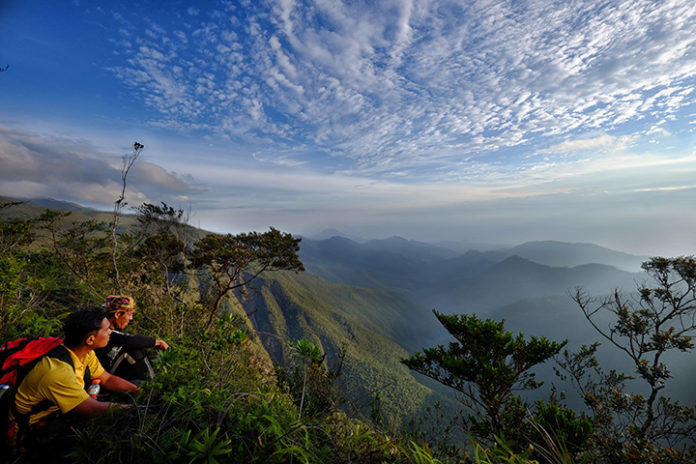 Trekkers on Mount Hamiguitan Range Wildlife Sanctuary.
Trekkers on Mount Hamiguitan Range Wildlife Sanctuary.
The heads of governments of the 10 Asean member-states have agreed to promote cooperation and partnerships within the region and with external partners in order to achieve sustainability, conservation, peace, economic growth and other dimensions of Asean Community-building.
The agreement was expressed in the Asean leaders’ vision statement on partnership for sustainability, which was adopted during the recent 34th Asean Summit held in Bangkok, Thailand.
Among many other regional concerns, the Asean leaders—of Brunei Darussalam, Cambodia, Indonesia, Lao PDR, Malaysia, Myanmar, the Philippines, Singapore, Thailand, and Vietnam—agreed to continue promoting biodiversity conservation and management, and to endeavor to mainstream biodiversity into the various development processes in Asean.
It will be done through the concerted efforts of member-states, and with the support of the Asean Centre for Biodiversity (ACB).
The ACB was established in 2005 as the Asean’s response to the challenge of biodiversity loss. It facilitates cooperation among Asean member-states, and with national, regional and international bodies from across sectors on the conservation and sustainable use of biodiversity, and the fair and equitable sharing of benefits from the use of such biodiversity in the region.
Dr. Theresa Mundita S. Lim, executive director of the ACB, noted that the leaders acknowledge that the conservation and sustainable use of biodiversity is an intergenerational responsibility that is entrusted to the present generation.
She lauded the support they expressed to the continuing conservation and sustainable use of Asean’s coastal and marine environment and ensuring food security, improving nutrition, and promoting benefits for the people.
Moreover, the vision statement recognizes that the diversity of life provides a multitude of opportunities for livelihood and economic development; contributes to poverty alleviation and development of technology and innovation; and serves as an effective adaptation and mitigation measure against climate-change impacts and natural disasters in the region.
The Asean leaders also agreed to promote partnership for sustainability in maintaining the region as an area of peace, freedom, and security, where differences and disputes are resolved by peaceful means; where states remain free of nuclear weapons and weapons of mass destruction; and where maritime cooperation is enhanced in accordance with internationally accepted treaties and principles, including the 1982 United Nations Convention on the Law of the Sea.
Other areas cited by the vision statement include enhancing dialogue and promoting cooperation on regional defense and security issues on humanitarian assistance and disaster relief, peacekeeping operations, maritime security, and cybersecurity.
The vision statement also covers reaffirming the importance of maintaining and promoting peace, security, stability, safety and freedom of navigation in and overflight above the South China Sea.
It also involves cooperating effectively with partners within and beyond the region to combat terrorism in all its forms and manifestations; strengthening cooperation on border management in accordance with domestic laws and policies to better safeguard the increasingly interconnected and integrated Asean Community by having its relevant sectoral bodies discuss common concerns, such as transnational crimes, human trafficking, illegal wildlife trade, illicit drug trafficking and cross-border challenges, including pandemics.
Another is that on committing to progressing negotiations on the Asean Extradition Treaty to strengthen the region’s resilience and capacity to combat transnational crimes.
The leaders also call for promoting dynamic, sustainable, equitable and inclusive economic growth in Asean; improving connectivity through sustainable infrastructure; achieving inclusivity through narrowing the development gaps within and between member-states, and promoting a green economy.
The Asean leaders are looking forward to enhancing sustainable development cooperation by promoting complementarities between the Asean Community Vision 2025 and the UN 2030 Agenda for Sustainable Development; and the launching of the Asean Centre for Sustainable Development Studies and Dialogue in Thailand in 2019 and its role in helping promote sustainable development cooperation in the region.
Other regional concerns covered by the vision statement on sustainability and partnerships include narrowing of development gaps, promoting smart and sustainable cities, cooperation on sustainable fisheries and management, promoting inclusive human capital development and public-private partnership initiatives.
It also involves strengthening the capacity of Asean to address the challenge of natural disasters and climate change, strengthening the preparedness of the region to deal with the trends of an aging society, and supporting efforts to intensify convergence among the member-states on technical-vocational education and training and workforce development.
The latest Asean vision statement demonstrates the full support of the 10 Asean member-states to Thailand’s chairmanship of the Asean, with the theme of “Advancing Partnership for Sustainability.”
It further strengthens the Bangkok Declaration of 1967, wherein the Asean declared to promote regional cooperation in the spirit of equality and partnership, and to secure for its peoples and for posterity the blessings of peace, freedom and prosperity, and Asean’s pledge to its peoples in the Asean Community Vision 2025, to realize a rules-based, people-oriented and people-centered Asean of One Vision, One Identity, One Community.









